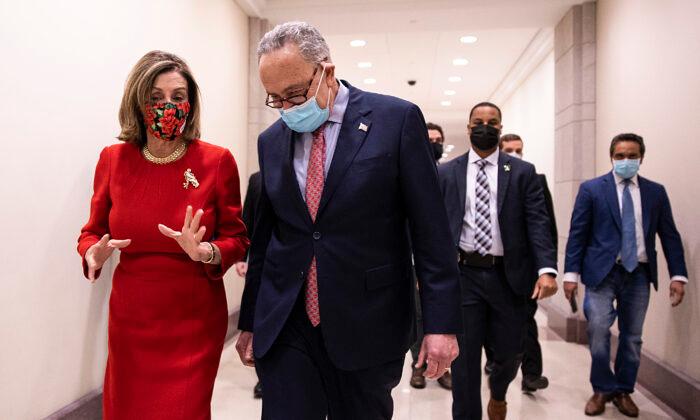WASHINGTON—After more than six months of gridlock, Congress has come to an agreement on a pandemic relief package, delivering long-awaited money to households and businesses. The stimulus package, worth $900 billion, is combined with a $1.4 trillion omnibus spending bill and several other legislative proposals.
The agreement leaves out two main sticking points in the talks—a liability shield for businesses against COVID-19 litigation, and funding for state and local governments.
“The deal in many ways resembles recent proposals from a bipartisan group of lawmakers and Treasury Secretary [Steven] Mnuchin, both of which cost over $900 billion,” the Committee for a Responsible Federal Budget (CRFB) stated in a report that analyzes the relief deal.
Direct Checks
The relief bill provides a $600 direct payment to many Americans. That’s half the size of the $1,200 checks provided under the Coronavirus Aid, Relief, and Economic Security Act (CARES Act) passed in March. The bill also provides an additional $600 for each child under age 17, which represents a $100 increase compared to the previous stimulus payment.The cash payment is subject to the same income limits as in the CARES Act, phasing out after $75,000 for individuals and $150,000 for married couples. A family of four could receive as much as $2,400 in payments.
The latest bill includes U.S. citizens who live in households with illegal immigrants who pay taxes using a special number (called ITIN filers). According to Hanauer, this will allow up to 1.7 million adults and 3.7 million children—who were previously excluded—to receive money.
Unemployment Insurance
The package extends the weekly extra unemployment insurance at $300 per week through March 14. That’s half of the $600 per week benefit that expired in July, but in line with President Donald Trump’s executive order in August that guaranteed $300 per week in enhanced unemployment from the federal government.The bill also extends the unemployment program for gig workers (independent contractors and temporary workers) through March 14. Pandemic Emergency Unemployment Compensation, which provided up to 13 additional weeks of benefits to those who had exhausted their regular state benefits, also is extended for 11 weeks.
Aid to Small Businesses
The relief package includes $284 billion for another round of Paycheck Protection Program (PPP) funds, which provides small businesses with forgivable loans to fund payroll and other business costs.The PPP program received overwhelming demand from small business owners since its introduction. The first applications for loans were accepted on April 3 under the CARES Act, but the initial round of funding of some $349 billion ran out about two weeks after the launch. Congress subsequently approved another $310 billion for PPP loans in April.
The hardest-hit businesses that received PPP grants earlier would be eligible to receive another round of funding.
The new package also includes $20 billion of Economic Injury Disaster Loan advance grants, which provides up to $10,000 for small businesses that are severely impacted by the ongoing crisis. The proposal also provides $15 billion in aid to shuttered entertainment venues, movie theaters, and cultural museums.
COVID Response
The legislation contains $22 billion in funding to states for testing, tracing, and COVID mitigation. For vaccine procurement and distribution, states and federal agencies will receive $29 billion in funding. Other aid includes support for health care providers ($9 billion) and mental health funding ($5 billion).Airlines
As part of the package, U.S. airlines secured $15 billion in additional aid to cover salaries through the end of March. The funding will require airlines to bring back more than 32,000 furloughed workers, according to media reports.School Aid
The package provides $82 billion for schools affected by the pandemic, including $54 billion for K–12 schools and $20 billion for colleges.Rental Assistance
The bill provides $25 billion in emergency rental assistance to help those who have difficulty in paying their rent. In addition, the proposal has a one-month extension of the nationwide eviction moratorium, through Jan. 31, 2021.The bill also expands funding for nutrition programs such as SNAP, as well as aid for farmers, small lenders, child care, and broadband.
Mnuchin said on Dec. 21 that the federal government will begin to deposit the direct payments into bank accounts next week.
“The good news is this is a very, very fast way of getting money into the economy. Let me emphasize: People are going to see this money at the beginning of next week,” Mnuchin said in an interview on CNBC.
Regarding the stimulus payments, Trump repeatedly called on Congress to increase the amount.
“Why isn’t Congress giving our people a Stimulus Bill?” the president asked on Twitter on Dec. 19.





